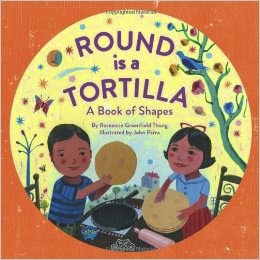From Kate Cruz:
I Am a Cowboy/Soy un Vaquero
Duke was my solution to a classic bilingual story time
dilemma—How do I to get the audience to
participate in an activity/song, regardless of the language they speak, while
keeping the program fresh each week?
I had heard a song called Cowgirl Clothes by GoGo Lingo and used that as a starting point.
It’s a cumulative song, but has a simple tune that is easy to remember. You can check it out here:
I decided not to keep it cumulative, making the song easier for the younger
audience to keep up with. I also decided to make the cowgirl a cowboy—because I
felt that the one less syllable per line made the song easier to sing…
"Soy una vaquera" = 6 syllables
"Soy un vaquero" = 5 syllables
…especially as the weeks went by and I was trying to fit
more vocab into the song for different themes. Trust me on this one.
The first felt piece I made was Duke. He is dressed plainly,
a blank slate. Then I created the clothing/accessories to match the cowboy
theme (a hat, a lasso, boots, a bandana, a guitar, and a horse). When choosing Duke’s accompanying items, make sure you can
easily fit the English and Spanish translations into the lines. 2-3 syllables
is best, 4 can be done—but it’s a mouthful.
I set up the board with Duke on one side, and the items on
the other. When I introduce the activity, I explain (going back and forth in
English and Spanish) that Duke is a little boy who loves to dress-up in
different costumes. Then I ask the audience what they think Duke will be
dressing as today based on the items on the board. “¡Sí—un vaquero! A cowboy!” Then we review the items in both
English and Spanish before we begin our song. I explain that we will begin in
English and then alternate between English and Spanish throughout. I also tell
them that even if they don’t know the whole song, that they can help me by
naming each item Duke is going to wear as we go along. But don’t worry—they
will pick it up quickly! Here is how I sing it:
I am a cowboy and a cowboy needs a…. (point
to felt piece and pause for answer from group) hat!
(place felt piece on Duke, repeat line without pause)
Pause for a moment here and remind the group
that the next verse will be in Spanish.
Soy un vaquero y un vaquero
necesita unas… (point to felt piece and pause for answer
from group) ¡botas!
(place felt piece on boy, repeat line without pause)
Pause a moment and remind them, “Y ahora en
Ingles/and now in English.”
I am a cowboy and a cowboy needs a…. (point
to felt piece and pause for answer from group) lasso!
(place felt piece on boy’s hand, repeat line without pause)
Pause a moment and remind them, “and now in
Spanish/y ahora en Español.”
Soy un vaquero y un vaquero
necesita un… (point to felt piece and pause for answer
from group) ¡pañuelo!
(place felt piece on boy, repeat line without pause)
Pause a moment and remind them, “Y ahora en
Ingles/and now in English.”
I am a cowboy and a cowboy needs a…. (point
to felt piece and pause for answer from group) guitar!
(place felt piece on boy’s hand, repeat line without pause)
Pause a moment and remind them, “and now in
Spanish/y ahora en Español.”
Soy un vaquero y un vaquero
necesita un… (point to felt piece and pause for answer
from group) ¡caballo!
(place felt piece next to boy, repeat line without pause)
(Taking a break from the song, tell the
group that Duke’s Mom is calling for him to come eat lunch—“It’s time to take
off your costume!”)
(Repeat song—this time do the Spanish lines
in English, and vice-versa. Take the felt pieces off the boy as you sing about
each item)
I don’t always
stick to a theme in my story time, but I try to pair at least one book to
Duke’s costume so it makes an easy transition in the program. For Duke the
cowboy, we stayed on the farm and smoothly transitioned to Clic, Clac, Muu: Vacas Escritoras/ Click,
Clack, Moo: Cows that Type by Doreen Cronin.
You could do this
activity in a variety of ways. I once did the entire song in English and then
in Spanish, and I’ve also thought about bringing in props/costume pieces
instead of using the felt board. If you have a small group, you can ask the
children to help you place the items onto Duke as you sing. Another idea is
to nix Duke all together, and instead create a background, adding items to
the scene throughout the song. For example, you could start with a simple
gray castle…
I am a castle and a castle needs a---MOAT!
(gate, flags, etc.)
This activity is
so versatile, and you can make it your own. Here are some other themes that I’ve done:
I Am a Barber/Soy un Barbero
I Am a Doctor/Soy un Doctor
I Am a Pirate/Soy un Pirata
I Am a Ranger/Soy un Guardabosque
Wow! So creative and fun! Thanks again Kate for sharing these super cute flannels with us. If you give them a try in your bilingual storytime, let us know how it goes! What other ideas can you come up with for Duke?
|

























